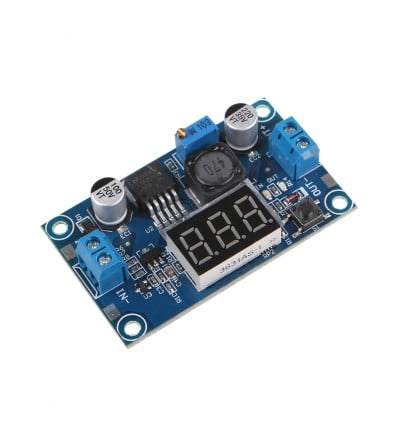International shipping Secure payment
No products
Prices are tax included
Product successfully added to your shopping cart
There are 0 items in your cart. There is 1 item in your cart.
This LM2596 based Voltage Regulation module is the perfect tool to help you wrangle those electrons and whip them into shape for your projects.
This product is no longer in stock
Free shipping on orders over R1250 - courier delivery and within South Africa
Wrangling electrons is never a simple task, as they are typically quite mischievous, getting excited at the touch of a button and always taking the easiest routes they can find through the circuit. Fortunately though, as Electron Wranglers we have access to all kinds of handy tools and Modules to help us enjoy effective wrangling without having to get the whips and lassoes out. One such set of awesome tools includes Voltage Regulators, which are designed to take in an incoming voltage, whip it into shape, and convert it into a different outgoing voltage on the other side. This is not just helpful, but is actually vital in Electronics, since almost every single component out there has a specific voltage and current requirement, and if those requirements aren’t met with generally high precision, things can go wrong in spectacular ways. This is why we try to stock as many different types of Voltage Regulators as we can get a hold of, with these LM2596 based step-down or buck modules being fantastic additions to our collection.
These extremely handy LM2596 Buck Modules are built to take in between 4.5V to 40, and convert it down to between 1.5V and 37V, and feature a reasonably beefy 20W capability along with an onboard 7-segment display for easy voltage readings of both the input and output. This module sports an onboard potentiometer for simple adjustments with a screwdriver (or fingernail), and with such a wide output voltage range, this module can be used for an exceptionally wide range of different Hobbyist Electronics applications. As such, if you’ve got a beefy high voltage Power Supply but want to power your small 3.3V, 5V or 12V projects, this modules can do it without hassle, and then once you’re done prototyping, you can use it for the next project too! Furthermore, as you may know, electronics measurements can drift over time as Components age and wear down, but with an onboard calibration memory, this module can be adjusted as necessary, after which the memory can store that adjustment and maintain a good level of precision even over many years of use and recalibration.
LM2596 20W Step-Down Buck Module - Technical Specifications: |
|
|
– DFRobot |
|
– 4.5V to 40V DC |
|
– 1.5V to 37V DC |
|
– 1.5V – Input must be 1.5V HIGHER than Output |
|
– 2A Constant | 3A Peak |
|
– 15W |
|
– 20W |
|
– Reverse Polarity | Overheating | Short Circuit |
|
– 3-Digit 7-Segment Display |
|
– ±85% @ ≤2A Load – 73% @ 3A Load |
|
– 150kHz |
|
– -40° to +120°C |
|
– 22g |
|
– 66 x 36 x 12mm |
Handy Tips for Using the LM2596 20W Step-Down Buck Module:
1: The onboard button can be used to switch between displaying input and output voltage. A single short press will switch between these.
2: The onboard display can be turned off if necessary by pressing and holding the button down for two seconds before releasing. After this, the display can be turned back on with a single short press of the button.
3: Although this module is capable of up to 3A and 20W, if you are using it for more than 2A or 15W then you will need to equip it with a heatsink to keep the regulator chip cool.
4: This module can be calibrated, and it’s recommended to calibrate it with a constant voltage supply and a multimeter when first acquiring it.
4.1: To enter calibration mode, press and hold the button down for four seconds before releasing it. This will take you to INPUT calibration mode, and the “IN” LED will turn on.
4.2: From the INPUT calibration mode, once again press and hold the button down for four seconds before releasing. This will take you to OUTPUT calibration mode, and the “OUT” LED will turn on.
4.3: In either of these calibration modes, a single short press is used to adjust the settings.
4.4: Once you are done calibrating INPUT and OUTPUT, press and hold the button for four seconds before releasing it to exit calibration mode and automatically save the settings into memory.
No customer reviews for the moment.
As self-proclaimed “Robo-holics”, DFRobot is a company comprised of over 100 staff members, of which 30% are engineers who love to build robots. It was started in 2008 with the goal of embracing and promoting open-source hardware, with a core focus on Arduino, Raspberry Pi and their very own LattePanda development boards. Since then, DFRobot have manufactured over 1300 unique modules, sensors and components that all work together and complement each other, allowing users like us to enjoy a full spectrum of cutting edge robotics and electronics without having to pay premium prices.
With the primary goal of developing and manufacturing great quality products, while making them accessible to as many people as possible, DFRobot are rapidly becoming one of the most common-place brands in the world of open-source robotics and electronics. With more than 1300 products developed in-house, and an impressive range of different categories and specialisations, there are few brands in the world who can compete in terms of quality, accessibility and genuine innovation.






